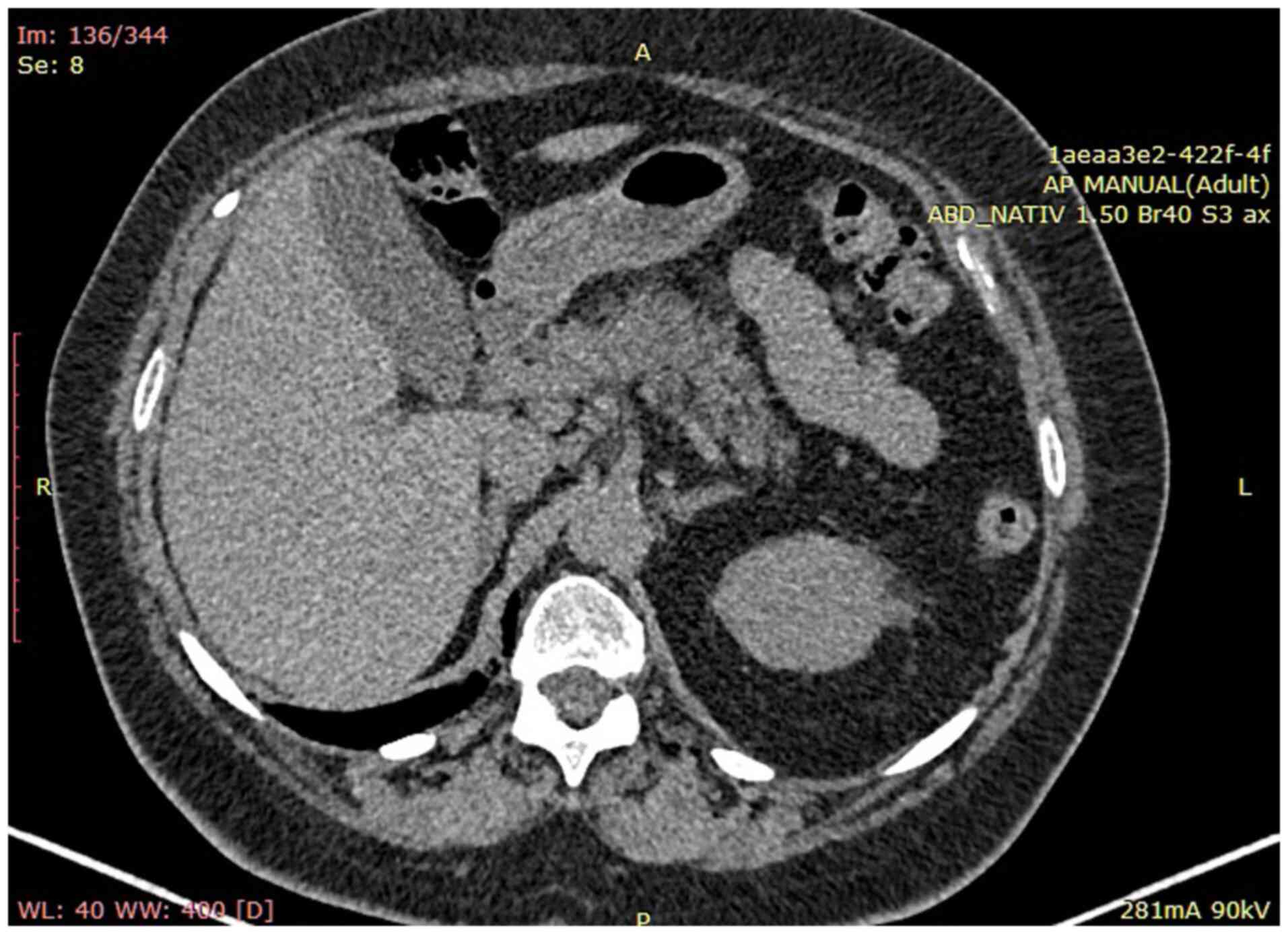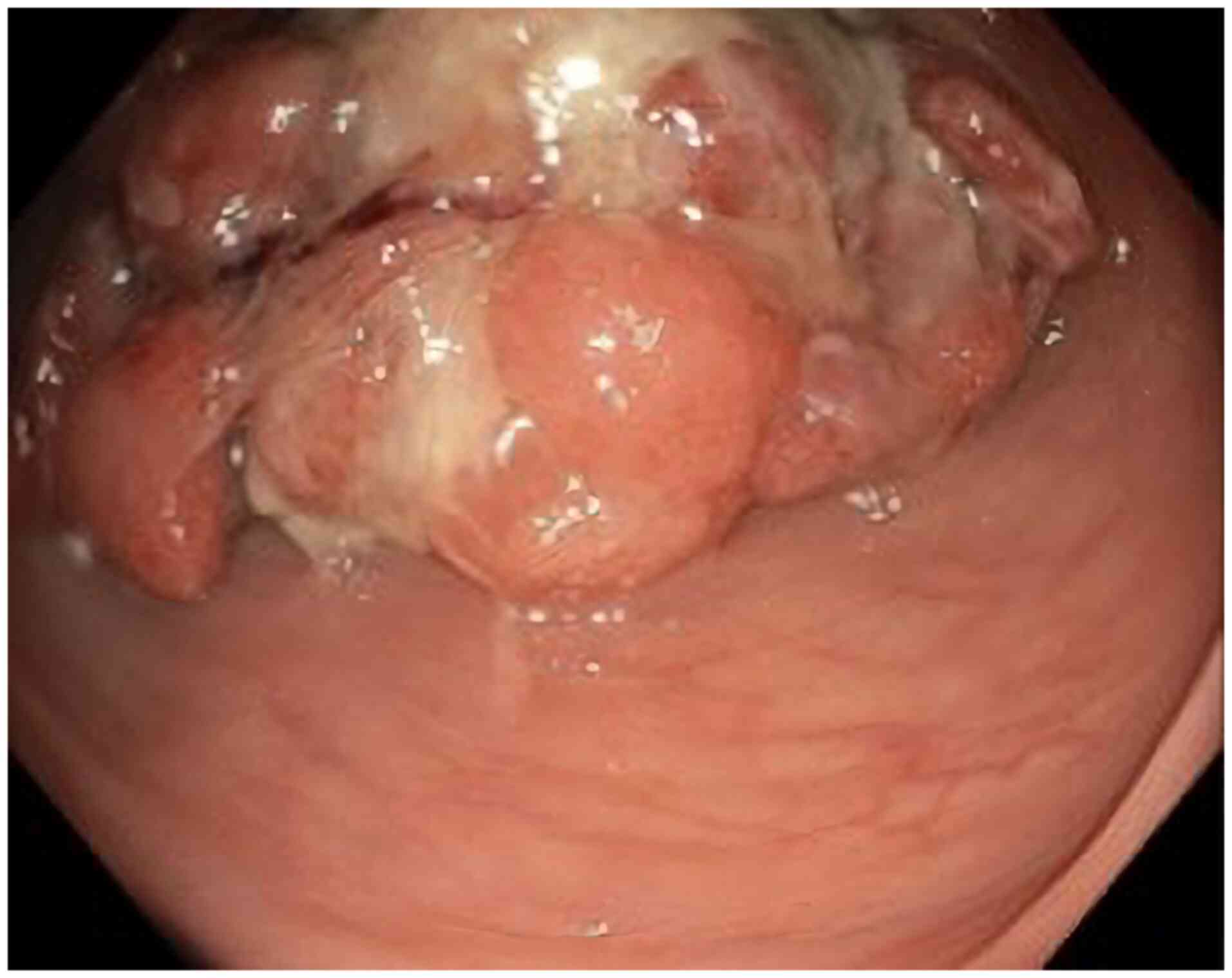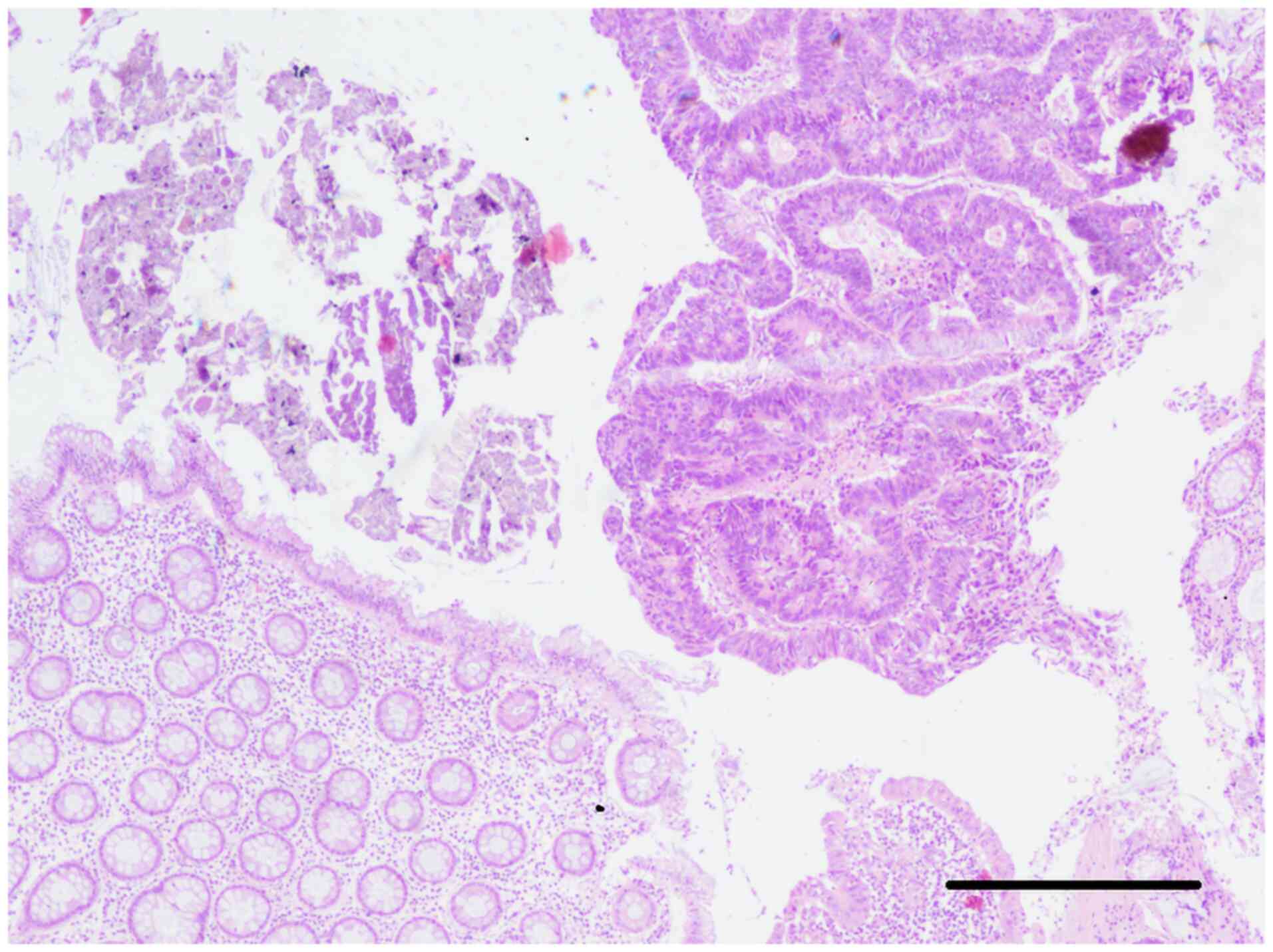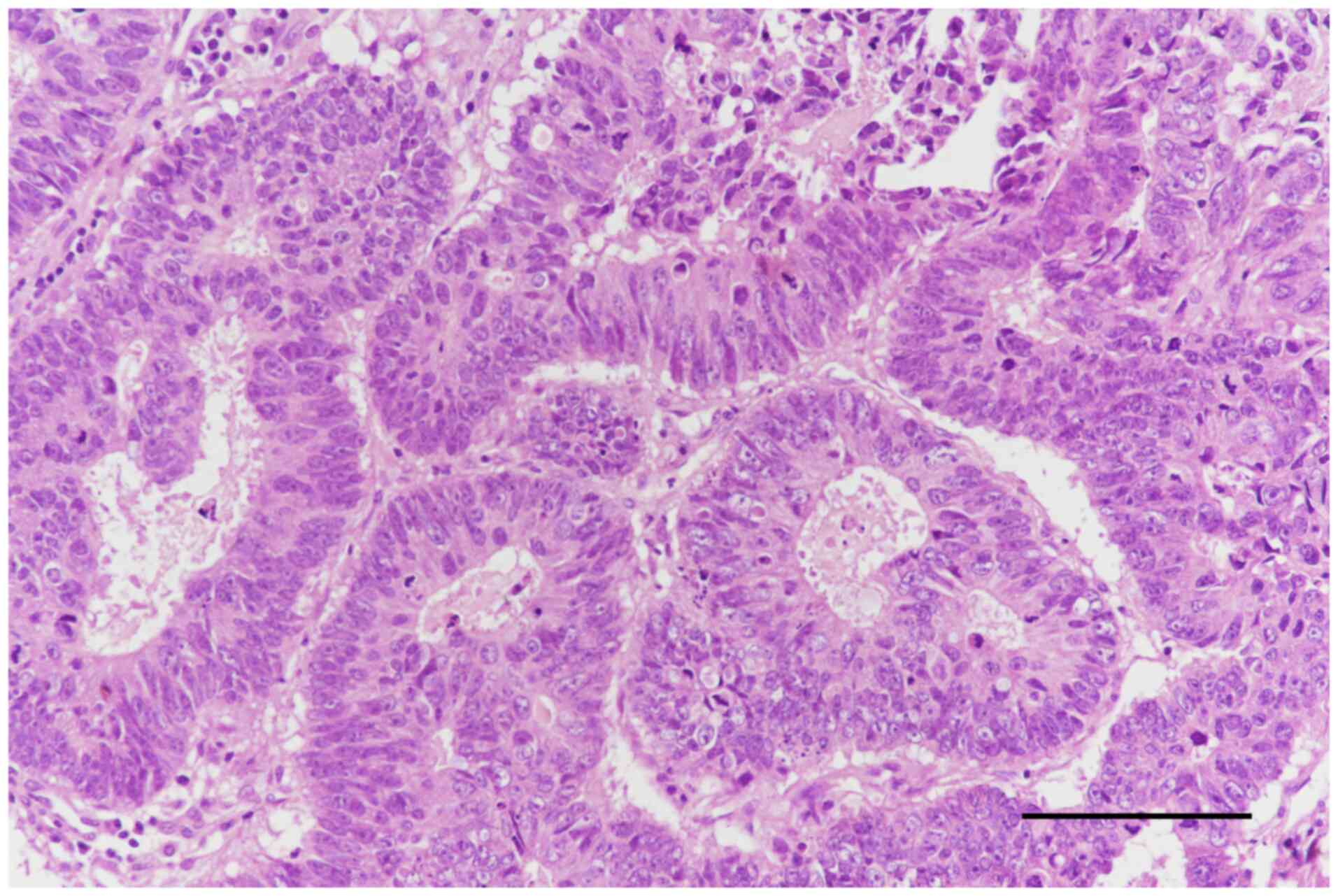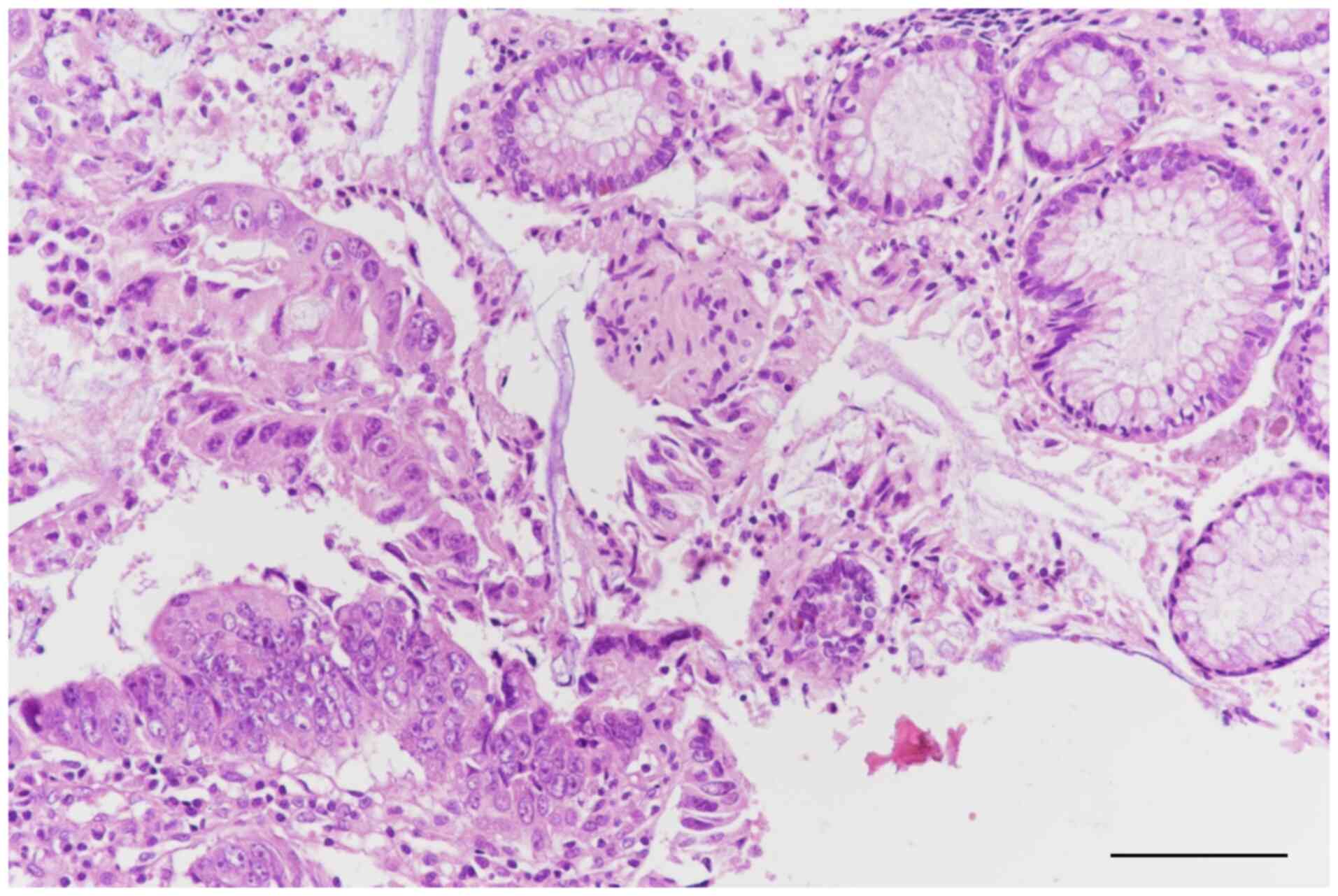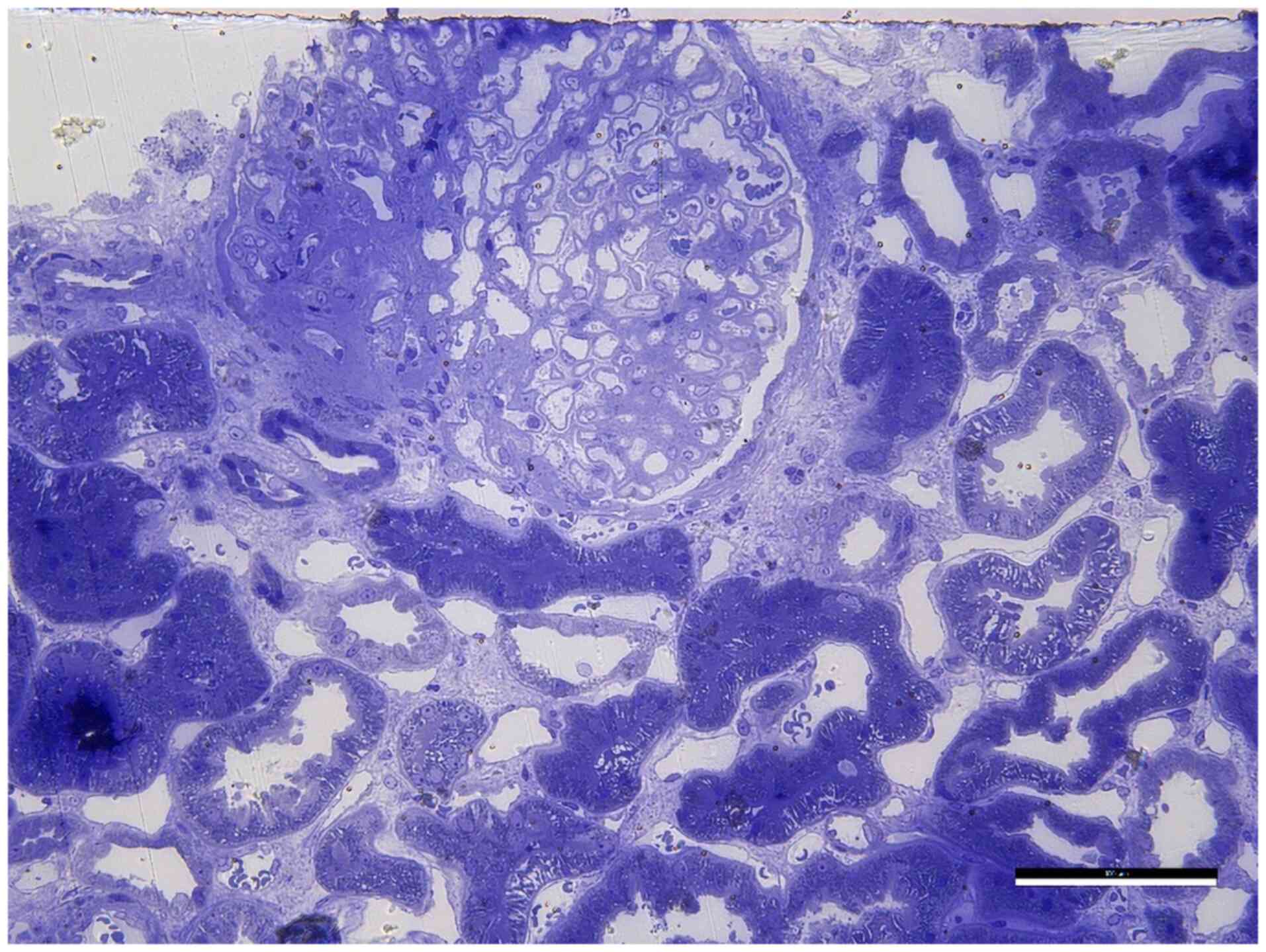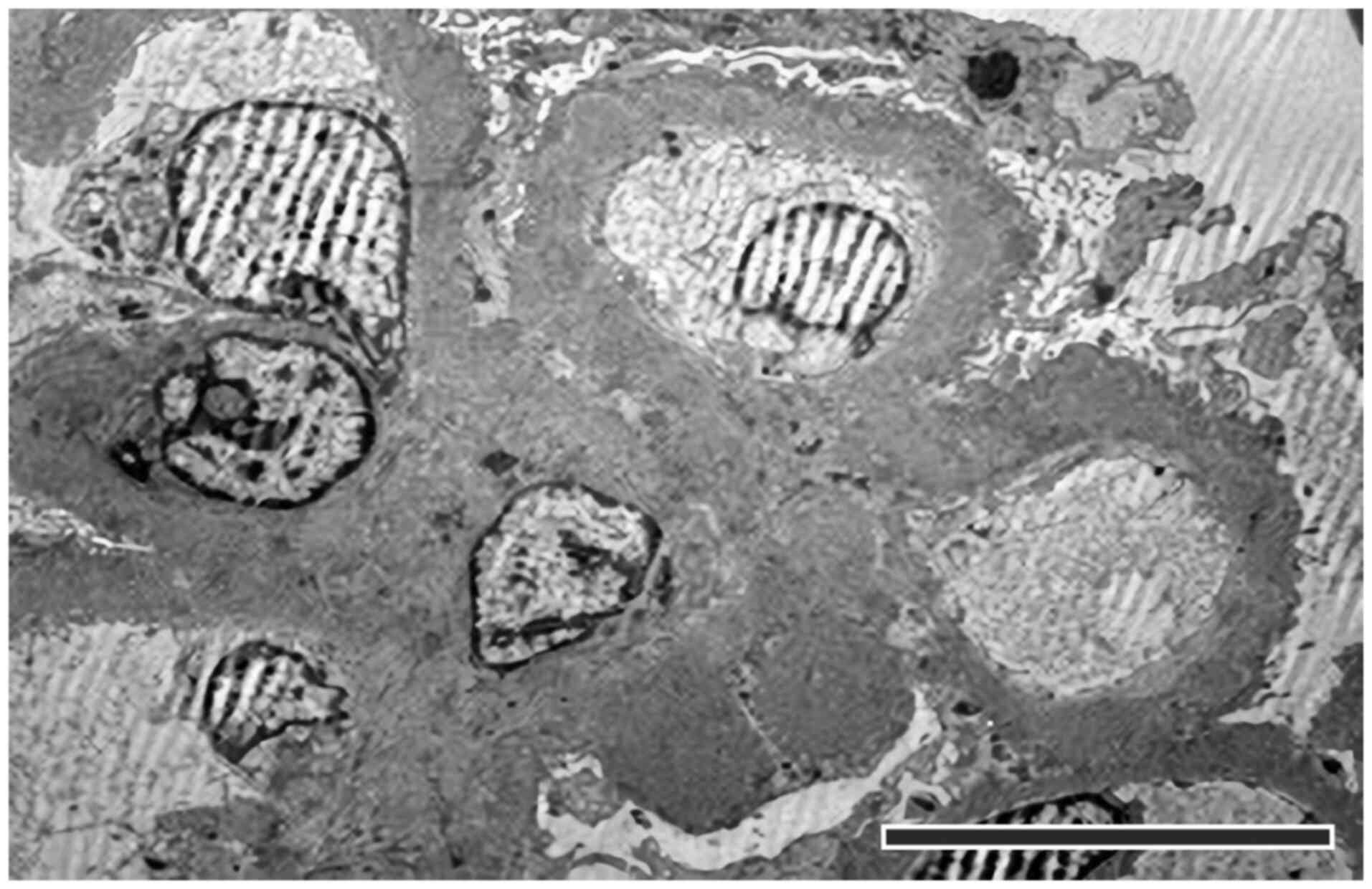Nephrotic syndrome as a possible indicator of colonic cancer: A case report
- Authors:
- Published online on: September 17, 2024 https://doi.org/10.3892/br.2024.1858
- Article Number: 170
-
Copyright: © Surugiu et al. This is an open access article distributed under the terms of Creative Commons Attribution License.
Abstract
Introduction
Paraneoplastic syndrome is used to describe the clinical manifestations that occur as a result of the secretion of substances by tumor cells, including hormones, growth factors, cytokines and tumor antigens (1). Paraneoplastic glomerulopathy was initially introduced by Galloway in 1922 in a case of nephrotic syndrome (NS) in connection with Hodgkin's disease (2). Furthermore, a study in 1966 revealed that a significant proportion (~11%) of NS cases observed in adults were linked with the presence of malignant tumors (3). Data collected from the Danish Kidney Biopsy Registry between 1985 and 2014 associated 16% of patients with glomerulopathy with cancer development (4,5). NS is defined by persistent urine protein excretion, primarily albumin, >3.5 g/24 h (adults) or 40 mg/h/m2 (children), indicating ‘nephrotic-range proteinuria’, usually with serum albumin levels below normal for adults (3.5 g/dl). Although not necessary for diagnosis, NS is frequently associated with peripheral edema, ascites, pleural effusion, hyperlipidemia (high serum cholesterol and triglycerides) or lipiduria (fatty casts or doubly refractile fat masses) (6). It encompasses various etiologies, including primary renal disorder such as minimal change disease, focal segmental glomerulosclerosis and membranous glomerulonephritis (MG). Moreover, NS can manifest as a result of systemic disorder that impacts the kidneys and other organs, such as amyloidosis or lupus erythematosus (6). Membranous nephropathy is the predominant glomerular disease that leads to NS associated with solid tumors (7,8). Association between membranous nephropathy and neoplasia has been reported but there is still limited understanding of the specific features of this association (referred to as MN-cancer) (7). The prevalence of MN-cancer varies between 1 and 22%, in France (9).
The solid cancers most frequently observed in association with MN include lung, bronchus and gastric cancer, as well as renal, prostate and thymus tumors. Colorectal, pancreatic, esophageal and hepatic carcinomas are among the other types of cancer associated with MN (10). Other types of glomerulopathy linked with neoplasia include minimal change disease, IgA nephropathy, focal segmental glomerulosclerosis and mesangiocapillary and crescentic glomerulonephritis (11,12). Minimal change disease is often associated with Hodgkin's lymphoma, renal cell carcinoma and thymoma (11,13). IgA nephropathy is associated with cancers of the respiratory tract, buccal cavity, nasopharynx and melanoma (11,14,15). Focal segmental glomerulosclerosis is connected to renal cell carcinoma and gastric and breast cancer (11,16). Mesangiocapillary glomerulonephritis is observed alongside renal cell and lung and bronchus carcinoma and thymoma (17). Crescentic glomerulonephritis is associated with various types of cancer, including renal cell, esophagus and ovarian carcinoma, as well as gastric cancer (11). Additionally, amyloidosis is suspected to be associated with renal cell carcinoma (18), while cancer-associated thrombotic microangiopathy is often seen in mucin-producing carcinoma, particularly of the stomach, lung and breast (19).
Paraneoplastic syndromes, which are rare disorders triggered by an immune response to malignancy, manifest in a variety of ways depending on the type of cancer and patient demographic. Paraneoplastic nephropathy, a kidney condition often seen in neoplasia. Notably, ovarian carcinoma in a 59-year-old patient from Korea (20) and lung cancer in an 80-year-old patient from China (21) were both associated with MN and nephropathy, respectively. Hodgkin's lymphoma, appearing in both a 9-year-old from Romania (22) and a 13-year-old from India (23), is also a common malignancy, although specific nephropathies were not detailed for these cases. By contrast, thymoma in a 49-year-old from China (24) and a 32-year-old from Korea (25) were linked to membranous nephropathy and focal segmental glomerulosclerosis, respectively. Other notable associations include meningioma in a 60- (26) and a 58-year-old (27) from India, with one case involving MN. Additionally, gastrointestinal stromal tumor was noted in a 69-year-old Japanese patient (28), though specific nephropathy details were not provided. These data highlight the wide age range and diverse types of cancer involved in paraneoplastic syndrome, with membranous nephropathy being a recurrent form of nephropathy across multiple types of cancer (Table I).
The clinical manifestations associated with NS include pronounced edema, specifically in the periorbital region, ankles and feet; proteinuria, characterized by the presence of foamy urine due to excessive protein excretion; increased body weight due to fluid retention; fatigue and decreased appetite (29). The diagnostic tests for NS include urine analysis, which can detect presence of protein, and blood tests that indicate low levels of albumin, decreased total protein levels and elevated cholesterol and triglyceride levels (29). Kidney biopsy is considered the gold standard in diagnosis of NS (30). The therapeutic approach for managing NS includes the utilization of angiotensin-converting enzyme (ACE) inhibitors and angiotensin II receptor blockers. These pharmacological agents mitigate both blood pressure levels and urinary protein excretion effectively. An additional therapeutic approach entails the use of diuretic medication to reduce edema by stimulating renal fluid excretion. Frequently prescribed diuretic medications include furosemide, spironolactone and thiazides. Statins are utilized to reduce cholesterol levels. To decrease risk of embolic events, it is imperative to administer anticoagulant medications (29). These include heparin and vitamin K antagonists, as well as directly acting oral anticoagulants such as direct factor Xa (such as rivaroxaban, apixaban, and endoxaban) and thrombin inhibitors (dabigatran) (31).
Case report
A 44-year-old Caucasian male was admitted to Emergency County Hospital (Craiova in March 2018, with a history of smoking (22 pack-years) and chronic ethanol consumption. The patient presented with abdominal distension and edema in the genital and leg regions. Medical history did not reveal any significant health conditions. Upon admission, vital signs were within normal range: Blood pressure, 130/80 mmHg; heart rate, 80 bpm; respiratory rate, 17 breaths/min and body temperature, 36.7˚C. The patient was alert with no signs of scleral icterus or anemic conjunctiva and lymph nodes were non-palpable. The patient did not report dyspnea and chest auscultation was normal.
The patient had notable edema in the lower extremities and pronounced scrotal and penile edema. Physical abdominal examination revealed flank and shifting dullness, indicating ascites. The patient also reported polyuria and dysuria. An initial EKG showed sinus rhythm with a heart rate of 87 bpm, regular QRS complex and no ST-T segment changes. An abdominal ultrasound in indicated an enlarged liver with a homogeneous structure and a moderate amount of ascitic fluid, with no pleural or pericardial effusion.
Initial laboratory investigations were notable for an inflammatory syndrome [erythrocyte sedimentation rate (ESR), 110 mm/h], normal blood cell count (white blood cells, 8,000/mm3, reference range 4,000-10,000/mm3; red blood cells=5x106/mm3, reference range 4-5.7x106/mm3; platelets=300,000/mm3, reference range 150,000-450,000/mm3), normal urea (38 mg/dl, reference range 20-40 mg/dl) and creatinine (0.9 mg/dl, reference range 0.8-1.2 mg/dl). Serum glucose (90 mg/dl, reference range 70-110 mg/dl), glycosylated hemoglobin (HbA1c) (5%, reference range, 4-6.4%), aspartate aminotransferase (20 U/l, reference range 5-34 U/l), alanine aminotransferase (24 U/l, reference range 3-44 U/l), prothrombin time (10.5 s, reference range 9.4-13.5 s) and international normalized ratio (INR) levels (0.9, reference range 0.8-1.16) were within normal ranges. Additionally, N-terminal pro-b-type natriuretic peptide (64 pg/ml, reference range <121 pg/ml) was tested and found to be within the normal range (Table II).
Further laboratory tests the following day confirmed the inflammatory syndrome, with increased ESR=130 mm/h, reference range <20 mm/h fibrinogen, 150 mg/dl, reference range 200,400 mg/dl) and C-reactive protein levels (6.87 mg/dl, reference range 0-5 mg/dl). The patient exhibited anemic syndrome (Hb, 10.5 g/dl, normal range 13.5-17.5 g/dl), hypoproteinemia (3.9 g/l, reference range 6-8.3 g/l) and hypoalbuminemia (1.4-2.2 g/dl, reference range 3.5-5.2 g/dl), as well as hypertriglyceridemia (213 mg/dl, reference range 50-150 mg/dl), hypercholesterolemia (475 mg/dl, reference range 70-220 mg/dl) and hyperuricemia (10.22 mg/dl, reference range 2.5-7.2 mg/dl). Serum potassium levels were normal (4 mmol/l, reference range 3.5-5.1 mmol/l). Normal values were also recorded for bilirubin (0.4 mg/dl, reference range <1.2 mg/dl), alkaline phosphatase (70 U/l, reference range 50-116 U/l) and γ-glutamyl transferase (35 U/l, reference range 0-55 U/l). Urine screening showed proteinuria (500 mg/dl) and total urinary protein of 12,500 mg/24 h (normal range 0-300 mg/24 h), with no cells or casts.
Serum protein electrophoresis levels were as follows: Albumin, 20.40% (normal range 54.30-66.00%), α1-globulin, 4.30% (normal range 1.20-3.30%), α2-globulin, 33.90% (normal range 8.30-15.00%), β1-globulin, 13.30% (normal range 6.50-11.00%), β2-globulin, 10.60% (normal range 2.50-7.00%) and γ-globulin, 17.50% (normal range 7.00-19.50%). Serum protein electrophoresis was conducted following the standard protocols established by the Emergency County Hospital of Craiova. Blood samples were collected following a 12-h fasting period by an experienced phlebotomist. To facilitate blood clotting, the samples were left at room temperature for 20 min. Serum was separated by centrifugation at 3,600 rpm for 10 min at 4˚C. After centrifugation, the clot was promptly removed, and the serum was stored at -20˚C until analysis. Serum protein electrophoresis was conducted using Hydragel 30(15) β1-β2 reagents, based on the principle of agarose gel separation, on a semi-automated HYDRASYS 2 SCAN system, following the manufacturer's instructions (32). Carcinoembryonic antigen (CEA, 9.46 ng/ml, reference range 0.00-4.70 ng/ml) and carbohydrate antigen (CA 19-9=82.47 U/ml, reference range 0.00-39.00 U/ml) levels were elevated, while other markers such as CA 72-4 (4.00 U/ml, reference range <6.90 U/ml), α-fetoprotein (2.40 ng/ml, reference range <7.00 ng.ml) and cytokeratin fragments (1.20 ng/ml, reference range <3.30 ng/ml) were within normal limits (Table III).
Further investigation revealed negative results for viral hepatitis panel, human immunodeficiency virus and Epstein-Barr virus. Additionally, antinuclear antibody (<1:100), anti-double-stranded DNA antibody (<25 UI/ml), prostate-specific antigen (1.3 ng/ml, reference range <2 ng/ml), thyroid function (triiodothyronine T3=2 nmol/l, reference range 1.3-3.1 nmol/l; thyroxine T4=75 nmol/l, reference range 66-181 nmol/l), complement levels (CH50=50 U/ml, reference range, 50-75 U/ml; C3=120 mg/dl reference range 90-180 mg/dl; C4=22 mg/dl, reference range 10-40 mg/dl) and anti-phospholipase A2 receptor (PLA2R) antibodies (<1:10, negative <1:10) were within normal ranges. Additionally, immune complexes were within the normal range (CIC <20 R.U./ml, negative <20 R.U./ml).
To determine the nature of NS (primary or secondary), the most frequent secondary etiologies were investigated. Abdominal paracentesis was performed for both diagnostic and therapeutic purposes. Laboratory results revealed serum ascites albumin gradient <1.1 g/dl, along with normal cytological examination and a negative test for Mycobacterium tuberculosis. Ascitic fluid samples were collected via paracentesis and analyzed within 2 h of collection. A volume of 10 ml of the fluid was centrifuged at 1,500 rpm for 5 min. After discarding the supernatant, the sediment was transferred onto glass slides to prepare smears. These smears were air-dried at room temperature and subsequently fixed with methyl alcohol or alcohol-ether mixture (1:1) for 2-3 min. After fixation, the smears were stained with Giemsa solution for 20-23 min. Following staining, the slides were air-dried and examined under a light microscope. Cytological examination was performed using a scan-screen method to detect any abnormalities, atypical cells, or neoplastic changes in cell morphology.
Abdominal computed tomography (CT) scan confirmed liver enlargement without pathological masses, normal diameter (12 mm) of the portal vein and a notable accumulation of ascitic fluid. Additionally, CT scan revealed multiple mesenteric lymphadenopathy, measuring up to 1.3 cm, and increased renal echogenicity. No pathological alterations were observed in the spleen, prostate, or pancreas (Fig. 1).
A superior digestive endoscopy did not reveal notable abnormalities. However, an inferior digestive endoscopy revealed a pedunculated polyp, which was biopsied for further examination (Fig. 2). The sample was first fixed in 10% neutral buffered formaldehyde, at room temperature for 24-48 h. Following fixation, the sample was embedded in paraffin and serial sections were cut at a thickness of 4 µm. The sections were stained with hematoxylin at room temperature for 5 min, followed by eosin for 2 min. The stained sections were examined under a light microscope at varying magnifications, in this case 20 and 40x. Histopathological examination revealed an adenomatous polyp with areas of moderately differentiated adenocarcinoma that did not involve the muscularis mucosae layer (Fig. 3, Fig. 4 and Fig. 5).
An inferior digestive endoscopy revealed a pedunculated polyp in the descending colon and an endoscopic polypectomy was subsequently performed. Histopathological examination confirmed the presence of a malignant polyp with areas of moderately differentiated adenocarcinoma infiltrating the submucosal layer, as well as regions classified as carcinoma in situ not extending beyond the muscularis mucosae layer (Fig. 3).
Given the fragmented state of the specimen, the multidisciplinary team concluded that the appropriate course of action was left colectomy with a bloc removal of regional lymph nodes. This decision was made following normal chest and pelvic CT and negative ascitic fluid smear cytology for malignancy, which conclusively excluded the presence of metastases. The pathological stage was determined to be IIIB, specifically classified as pT2pN1bM0 using the TNM staging system (33).
The patient underwent eight courses of adjuvant chemotherapy of oxaliplatin (130 mg/m2 once every three weeks and oral capecitabine 1,000 mg/m2 twice a day for 14 days, followed by 7 days off. The adjuvant chemotherapy was administered at the usual dose, since the renal function remained stable, with no notable adverse effects observed.
Kidney biopsy (ultrasound-guided) revealed membranous nephropathy, stage 3 (Fig. 6) with thickening of the glomerular basement membrane (GBM), indicating moderate progression of the disease, due to the deposition of immune complexes. Kidney biopsy revealed a fragment of connective and renal tissue with a single glomerulus. The glomerulus showed segmental sclerosis affecting ~25% of its structure, with thickened capillary loop walls. There were rare interstitial foam cells and discrete lipid load in tubular epithelia. Arteries and arterioles were normal and there was mild interstitial fibrosis without interstitial inflammation (Fig. 7). Electron microscopy examination showed a glomerulus with segmental sclerosis and some permeable capillaries. GBM was thickened, containing numerous dense deposits on the epithelial and intramembrane surfaces, along with rare large hump-like deposits. Some capillaries exhibited continuous endothelium and intraluminal platelets. A circumferential hyaline deposit was noted at the level of the afferent arteriole, which narrowed the lumen. Biopsy fragments were fixed in 2% neutral buffered glutaraldehyde followed by 1% buffered osmium tetraoxide, embedded in PolyBed 812® resin with polymerization for 72 h at 60˚C, and sectioned as seriate 1 µm semithin and respectively 0.1 µm thin sections. Semithin sections were stained with toluidine blue for light microscopy evaluation, and for ultrastructural microscopy, 0.1 µm-ultrathin sections were collected on copper grids and examined under an electron microscope.
The patient was advised to reduce the dietary sodium (maximum 2 g/day), saturated fat and cholesterol intake. Initial management focused on diuretic therapy (furosemide, 40 mg, 3 times/day, intravenous; spironolactone, 100 mg/day, orally), with vigilant monitoring of serum electrolytes. To decrease proteinuria, angiotensin II enzyme inhibitor was used (perindopril, 5 mg/day, orally). For the restoration of serum albumin levels, intravenous administration of human albumin (50 g/l) was implemented once daily. Thromboembolic events were prevented via subcutaneous administration of enoxaparin (1 mg/kg) at 12-h intervals, followed by vitamin K antagonists (acenocumarol 2 mg/day, oral) with monitoring of INR (maintained between 1.8 and 2.0) and albumin levels. Notably, prophylactic antibiotic (cefuroxime 500 mg x 2/day, 7 days) therapy was initiated from hospitalization. At last follow-up (January 2020), clinical condition improved, including a reduction in peripheral edema.
Discussion
In the present case, typical causes of ascitic syndrome, including liver cirrhosis, ascites due to heart failure or peritoneal carcinomatosis, were considered (34). Given the relatively young age, bacillary peritonitis was initially considered as a potential cause, but this hypothesis was excluded following cytology and microbiological (Mycobacterium tuberculosis) analysis of ascites fluid obtained via paracentesis. The detection of abdominal adenopathy on CT examination suggested lymphoma; however, blood tests ruled out this diagnosis.
The diagnosis of NS prompted consideration of potential underlying primary glomerulonephritis. The conclusive determination of the patient condition was achieved through a systematic process of excluding potential causes of secondary NS, such as drugs, infection or multisystemic etiology (35). The presence of an unexplained inflammatory syndrome, coupled with perturbations in tumor marker levels, prompted imaging assessment of the gastrointestinal tract, leading to the identification of a colonic adenocarcinomatous polyp. Notably, endoscopic examination play a pivotal role in the timely detection of digestive malignancies (36) and empirical evidence suggests that screening strategies contribute to a decrease in both the incidence and mortality associated with colorectal cancer (37).
The precise mechanisms underlying development of glomerular disease as a result of malignancy are not yet fully comprehended (1,17,38,39). The occurrence of remission in glomerular disease following cancer removal via surgery or anticancer medications, along with the subsequent relapse upon return of neoplasia, indicates the presence of paraneoplastic mechanisms (37). One potential mechanism is the production of autoantibodies that specifically target a tumor antigen that shares immunological characteristics with a component of the glomerulus, resulting in formation of immune complexes in the local area. Trapping of these immune complexes in glomerular capillaries or deposition of antibodies bound to the tumor antigen within the glomerular membrane may be involved. External factors, such as oncogenic viruses, also need to be considered (40).
Identification of IgG subtypes within immune deposits in membranous nephropathy has the potential to assist in differentiation of various diagnoses. The IgG4 subtype is prevalent in cases of idiopathic and recurrent membranous nephropathy, whereas IgG1, IgG2 and IgG3 subtypes are more frequently observed in secondary membranous nephropathy and allograft cases (41). These findings highlight the role of immunological mechanisms in pathogenesis of renal involvement in systemic malignancy, which is relevant in the present case of paraneoplastic NS (42,43).
Paraneoplastic nephropathy represents a key intersection between kidney disease and systemic malignancy, illustrating how renal manifestations can facilitate diagnosis of unsuspected cancers. NS arises via various mechanisms influenced by the presence of malignancies. Membranous nephropathy is a predominant form of glomerular disease associated with a range of solid tumors, underscoring the need for clinicians to remain vigilant when encountering unexplained NS. The present case highlighted that paraneoplastic syndromes, while rare, can present uniquely and lead to early detection of underlying malignancies. Further research is essential in elucidating these associations, developing targeted therapeutic strategies and enhancing understanding of the pathophysiological underpinnings of paraneoplastic syndrome to improve both diagnosis and management of affected patients.
Acknowledgements
Not applicable.
Funding
Funding: No funding was received.
Availability of data and materials
The data generated in the present study may be requested from the corresponding author.
Authors' contributions
RS and ȘBV conceived the study. CDN, DM, DeP, MA, AVGD, GGD, RES, MDS and DaP performed experiments and analyzed data. MA, RS and AVGD wrote the manuscript. GGD, RES, MDS and AVGD edited and reviewed the manuscript. GGD, AVGD and MDS supervised the study. All authors have read and approved the final manuscript. RS and AVGD confirm the authenticity of all the raw data.
Ethics approval and consent to participate
Written informed consent was obtained from the patient.
Patient consent for publication
Written informed consent has been obtained from the patient.
Competing interests
The authors declare that they have no competing interests.
References
|
Ronco PM: Paraneoplastic glomerulopathies: New insights into an old entity. Kidney Int. 56:355–377. 1999.PubMed/NCBI View Article : Google Scholar | |
|
Galloway J: Remarks on Hodgkin's disease. Br Med J. 2:1201–1208. 1922.PubMed/NCBI View Article : Google Scholar | |
|
Lee JC, Yamauchi H and Hopper J JR: The association of cancer and the nephrotic syndrome. Ann Intern Med. 64:41–51. 1966.PubMed/NCBI View Article : Google Scholar | |
|
Birkeland SA and Storm HH: Glomerulonephritis and malignancy: A population-based analysis. Kidney Int. 63:716–721. 2003.PubMed/NCBI View Article : Google Scholar | |
|
Heaf JG, Hansen A and Laier GH: Quantification of cancer risk in glomerulonephritis. BMC Nephrol. 19(27)2018.PubMed/NCBI View Article : Google Scholar | |
|
Glassock RJ, Fervenza FC, Hebert L and Cameron JS: Nephrotic syndrome redux. Nephrol Dial Transplant. 30:12–17. 2015.PubMed/NCBI View Article : Google Scholar | |
|
Lefaucheur C, Stengel B, Nochy D, Martel P, Hill G and Rossert J: GN-PROGRESS Study Group. Membranous nephropathy and cancer: Epidemiologic evidence and determinants of high-risk cancer association. Kidney Int. 70:1510–1517. 2006.PubMed/NCBI View Article : Google Scholar | |
|
Davison A: Renal diseases associated with malignancies. Nephrol Dial Transplant. 16:13–14. 2001.PubMed/NCBI View Article : Google Scholar | |
|
Bacchetta J, Juillard L, Cochat P and Droz JP: Paraneoplastic glomerular diseases and malignancies. Crit Rev Oncol Hematol. 70:39–58. 2009.PubMed/NCBI View Article : Google Scholar | |
|
Monga D: Chapter 6: Glomerular Diseases and Cancer, 2016. Available from: https://www.asn-online.org/education/distancelearning/curricula/onco/Chapter6.pdf. Accessed January 4, 2019. | |
|
Jhaveri KD, Shah HH, Calderon K, Campenot ES and Radhakrishnan J: Glomerular diseases seen with cancer and chemotherapy: A narrative review. Kidney Int. 84:34–44. 2013.PubMed/NCBI View Article : Google Scholar | |
|
Lionaki S, Marinaki S, Panagiotellis K, Tsoumbou I, Liapis G, Vlahadami I, Tzioufas A, Sfikakis P and Boletis I: Glomerular diseases associated with malignancies: Histopathological pattern and association with circulating autoantibodies. Antibodies (Basel). 9(18)2020.PubMed/NCBI View Article : Google Scholar | |
|
González-Fontal GR, Restrepo JG and Henao-Martínez AF: Minimal-change disease as a paraneoplastic syndrome in a patient with ovarian carcinoma. NDT Plus. 4:427–429. 2011.PubMed/NCBI View Article : Google Scholar | |
|
Sanathkumar HT, Thirumalvalavan K, Raj TY, Srinivasaprasad ND, Sujith S and Fernando EM: Association of IgA nephropathy with squamous cell carcinoma of the tongue: -Case report and review of literature. Indian J Nephrol. 31:290–292. 2021.PubMed/NCBI View Article : Google Scholar | |
|
Rehnberg J, Ludvigsson JF, Carrero JJ and Emilsson L: Cancer risk in patients with immunoglobulin A nephropathy: A Swedish population-based cohort study. Nephrol Dial Transplant. 37:749–759. 2022.PubMed/NCBI View Article : Google Scholar | |
|
Dabrowski D, Ozluk E, Barbeito S and Wei EX: Focal segmental glomerulosclerosis preceding type 2 papillary renal cell carcinoma. Case Rep Pathol. 15(8811905)2020.PubMed/NCBI View Article : Google Scholar | |
|
Lien YH and Lai LW: Pathogenesis, diagnosis and management of paraneoplastic glomerulonephritis. Nat Rev Nephrol. 7:85–95. 2011.PubMed/NCBI View Article : Google Scholar | |
|
Vanatta PR, Silva FG, Taylor WE and Costa JC: Renal cell carcinoma and systemic amyloidosis: Demonstration of AA protein and review of the literature. Hum Pathol. 14:195–201. 1983.PubMed/NCBI View Article : Google Scholar | |
|
Babu KG and Bhat GR: Cancer-associated thrombotic microangiopathy. Ecancermedicalscience. 28(649)2016.PubMed/NCBI View Article : Google Scholar | |
|
Kim YT, Rha SY, Shim CY, Sohn JH, Kim C, Yu NC, Chung HC, Kim JH, Han DS, Kim BS and Roh JK: A case of paraneoplastic nephrotic syndrome in a patient with ovarian carcinoma. Yonsei Med J. 44:539–543. 2003.PubMed/NCBI View Article : Google Scholar | |
|
Yu X, Fan Z, Chen W and Wang Z: Lung cancer with nephrotic syndrome as a paraneoplastic syndrome: A case report. Mol Clin Oncol. 13(86)2020.PubMed/NCBI View Article : Google Scholar | |
|
Sfrijan D, Tieranu I, Necula I, Popa L and Balgradean M: Nephrotic syndrome, paraneoplastic syndrome associated to hodgkin lymphoma. Maedica (Bucur). 11:64–67. 2016.PubMed/NCBI | |
|
Padmanaban PD, Jayaraman D, Shanmugam SG and Geminiganesan S: Nephrotic syndrome and hodgkins lymphoma-an unusual association. EJIFCC. 33:262–267. 2022.PubMed/NCBI | |
|
Liu H, Dong Z, Zhang M, Pang R, Xu J, He P, Mei W, Zhang S, You G and Li W: Case report: Complex paraneoplastic syndromes in thymoma with nephrotic syndrome, cutaneous amyloidosis, myasthenia gravis, and Morvan's syndrome. Front Oncol. 12(1002808)2022.PubMed/NCBI View Article : Google Scholar | |
|
Yoo SH, Kim HJ, Kim JH, Lee GW, Lee JH, Kim SH, Kim JW, Kim JW, Lee JO, Kim YJ, et al: Nephrotic syndrome associated with metastatic thymoma treated with chemotherapy. Medicine (Baltimore). 96(e5408)2017.PubMed/NCBI View Article : Google Scholar | |
|
Sardhara J, Shukla M, Jamdar J, Jaiswal AK, Jaiswal S, Kaul A, Bhaisora KS, Das KK, Mehrotra A and Behari S: Paraneoplastic nephrotic syndrome in a patient with planum sphenoidale meningioma. Asian J Neurosurg. 13:864–866. 2018.PubMed/NCBI View Article : Google Scholar | |
|
Zachariah PP, Mathew A, Rajesh R, Kurien G and Unni VN: Nephrotic syndrome associated with meningioma. Indian J Nephrol. 23:63–66. 2013.PubMed/NCBI View Article : Google Scholar | |
|
Takane K, Midorikawa Y, Yamazaki S, Kajiwara T, Yoshida N, Kusumi Y and Takayama T: Gastrointestinal stromal tumor with nephrotic syndrome as a paraneoplastic syndrome: A case report. J Med Case Rep. 8(108)2014.PubMed/NCBI View Article : Google Scholar | |
|
Moța E, Văduva C and Zaharie S: Compendium of nephrology 1st Edition, Editura Medicală Universitară, Craiova, 2010. | |
|
Farahani E, Nili F, Moghimian M, Jahanzad I, Minoo FS, Abdollahi A and Salarvand S: Analysis of prevalence and trends in the biopsy-proven native kidney diseases in Iranian population: A 12-year survey from a referral center. Iran J Pathol. 18:202–209. 2023.PubMed/NCBI View Article : Google Scholar | |
|
Longo D, Fauci A, Kasper D, Hauser S, Jameson J and Loscalzo J: Harrison's Manual of Medicine. 18th edition. ALL, București, 2013. | |
|
Amin Nordin FD, Mohd Khalid MKN, Abdul Aziz SM, Mohamad Bakri NA, Ahmad Ridzuan SN, Abdul Jalil J, Habib A and Yakob Y: Performance comparison of EasyFix G26 and HYDRASYS 2 SCAN for the detection of serum monoclonal proteins. J Clin Lab Anal. 34(e23254)2020.PubMed/NCBI View Article : Google Scholar | |
|
Vogel JD, Felder SI, Bhama AR, Hawkins AT, Langenfeld SJ, Shaffer VO, Thorsen AJ, Weiser MR, Chang GJ, Lightner AL, et al: The American Society of Colon and Rectal Surgeons Clinical Practice Guidelines for the Management of Colon Cancer. Dis Colon Rectum. 65:148–177. 2022.PubMed/NCBI View Article : Google Scholar | |
|
Raza A and Aggarwal S: Membranous Glomerulonephritis. StatPearls Publishing, Treasure Island, FL, 2023. Available from: https://www.ncbi.nlm.nih.gov/books/NBK499865/. | |
|
Ho W and Sanyal A: Ascites: Diagnosis and management. Med Clin North Am. 93:801–817. 2009.PubMed/NCBI View Article : Google Scholar | |
|
Nishi S, Ubara Y, Utsunomiya Y, Okada K, Obata Y, Kai H, Kiyomoto H, Goto S, Konta T, Sasatomi Y, et al: Evidence-based clinical practice guidelines for nephrotic syndrome 2014. Clin Exp Nephrol. 20:342–370. 2016.PubMed/NCBI View Article : Google Scholar | |
|
Mitruţ P, Enescu A, Streba LA, Burada F, Cojocaru G, Simionescu C, Mărgăritescu C and Genunche-Dumitrescu A: The endoscopic and morphological forms of early gastric cancer. Rom J Morphol Embryol. 48:373–379. 2007.PubMed/NCBI | |
|
Buskermolen M, Cenin DR, Helsingen LM, Guyatt G, Vandvik PO, Haug U, Bretthauer M and Lansdorp-Vogelaar I: Colorectal cancer screening with faecal immunochemical testing, sigmoidoscopy or colonoscopy: A microsimulation modelling study. BMJ. 367(l5383)2019.PubMed/NCBI View Article : Google Scholar | |
|
Faria TV, Baptista MA, Burdmann EA and Cury P: Glomerular deposition of immune complexes as a first manifestation of malignant melanoma-a case report. Ren Fail. 32:1223–1225. 2010.PubMed/NCBI View Article : Google Scholar | |
|
Takeda S, Chinda J, Murakami T, Numata A, Iwazu Y, Akimoto T, Hamano Y, Muto S, Takahashi M and Kusano E: Development of features of glomerulopathy in tumor-bearing rats: A potential model for paraneoplastic glomerulopathy. Nephrol Dial Transplant. 27:1786–1792. 2012.PubMed/NCBI View Article : Google Scholar | |
|
Ohtani H, Wakui H, Komatsuda A, Okuyama S, Masai R, Maki N, Kigawa A, Sawada K and Imai H: Distribution of glomerular IgG subclass deposits in malignancy-associated membranous nephropathy. Nephrol Dial Transplant. 19:574–579. 2004.PubMed/NCBI View Article : Google Scholar | |
|
Stepan AE, Mărgăritescu C, Stoica LE, Stepan MD and Simionescu CE: Clear cell renal cell carcinomas-epithelial and mesenchymal immunophenotype. Rom J Morphol Embryol. 59:1189–1194. 2018.PubMed/NCBI | |
|
Stepan AE, Ciurea RN, Drăgoescu PO, Florescu MM and Stepan MD: Immunoexpression of transcription factors in urothelial bladder carcinomas. Rom J Morphol Embryol. 58:863–869. 2017.PubMed/NCBI |



